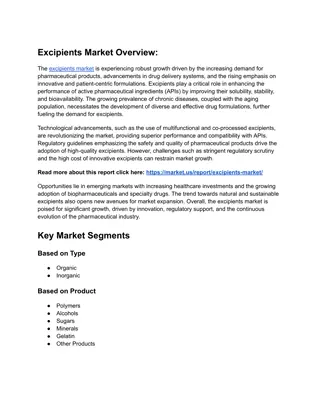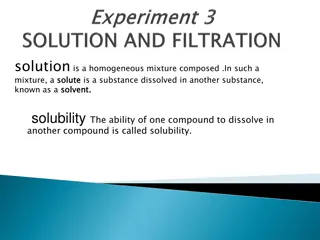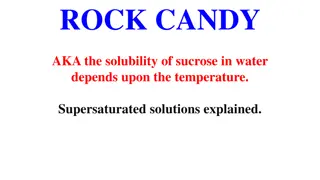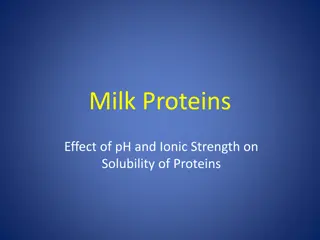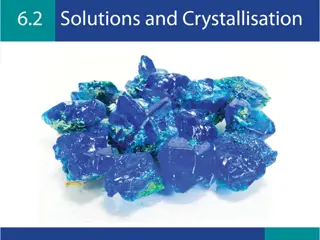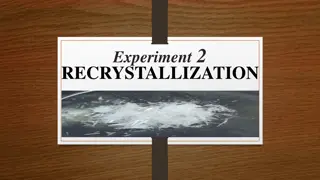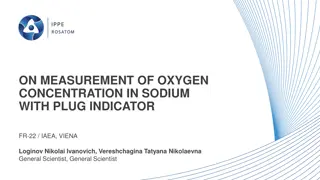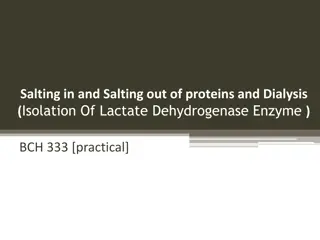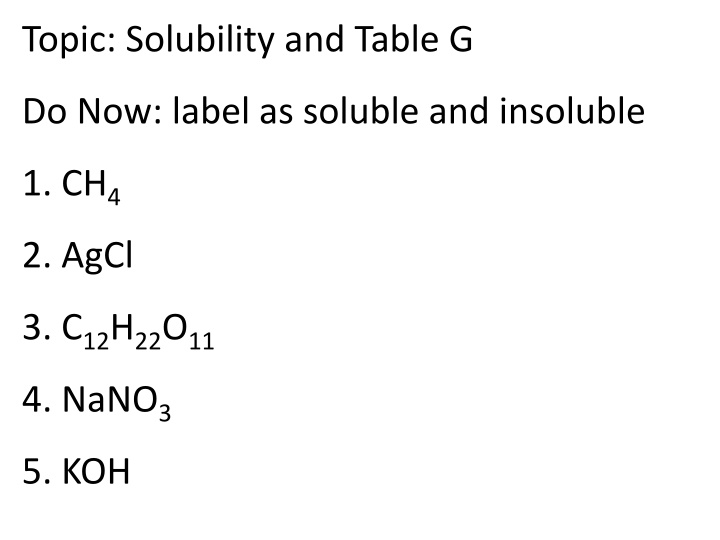
Understanding Solubility: Factors and Examples
Delve into the world of solubility with a focus on differentiating between soluble and insoluble compounds, understanding the factors affecting solubility, and exploring the relationship between solvents and solutes. Discover how temperature, pressure, and the nature of the substances impact their ability to dissolve in various solvents.
Download Presentation

Please find below an Image/Link to download the presentation.
The content on the website is provided AS IS for your information and personal use only. It may not be sold, licensed, or shared on other websites without obtaining consent from the author. If you encounter any issues during the download, it is possible that the publisher has removed the file from their server.
You are allowed to download the files provided on this website for personal or commercial use, subject to the condition that they are used lawfully. All files are the property of their respective owners.
The content on the website is provided AS IS for your information and personal use only. It may not be sold, licensed, or shared on other websites without obtaining consent from the author.
E N D
Presentation Transcript
Topic: Solubility and Table G Do Now: label as soluble and insoluble 1. CH4 2. AgCl 3. C12H22O11 4. NaNO3 5. KOH
Water is often used as a solvent Not everything dissolves in water Soluble = dissolves in water = aq Insoluble = doesn t dissolve in water Miscible = 2 liquids that dissolve Immiscible = 2 liquids that don t dissolve
How can you tell.?!!!?? Like Dissolve Like Water is polar, so most polar compounds will dissolve in water Things that dissolve in water Soluble ionic compounds use Table F Acids - start with H except H2O H2O2 ex HCl Bases - metal + OH and NH3 ex. NaOH Polar covalent molecules Remember polar = asymmetrical = poles nonpolar = symmetrical = no poles
Determining if an ionic compound is soluble (aq) or NOT LOOK AT TABLE F LiOH Cu(NO3)2 AgCl2 MgS NaS2 KOH aq aq Insoluble = s Insoluble = s aq aq
Solubility = the max amount of solute that can be dissolved in a solvent Factors that affect the rate a species dissolves Increasing temperature stirring (agitation) Crushing (smaller particle size)
Solubility Many solids and gases dissolve in water As you increase the temperature, you can dissolve more solid Does this work the same with gas? NOT the same for gases as you increase temp, gas molecules KE ? To get gases dissolve, decrease temperature and increase pressure
Summary: Factors Affecting Solubility Nature of the solvent and the solute: LIKE DISSOLVES LIKE Temperature Pressure (for systems with gases)
Solubility curves show the relationship between solubility and temperature. Can you guess which of these compounds are gases?! How do you know?!
Reading a solubility curve! Table G tells you the max amount of solute you can dissolve in 100 g of H2O at a given temperature
How much H2O is required to just dissolve 100 g NaNO3 at 20 C? 89 g
Problem: How much KCl will dissolve in 100g of water at 50 C? 42 g
On the line saturated (full, cannot hold any more solute Below the line unsaturated (can hold more solute) Above the line supersaturated (holding more solute then it should very unstable)
Supersaturated Solution (this picture is showing the addition of 100 g of glucose to 100ml of water at 250C) Note: at 250C, only 91g of glucose will dissolve in 100 ml of water Let s see what happens



